
Toda Tribe priests
Whilst planning my trip to South India in 2016 I spent a good many hours scouring what information Google maps can provide, in particular looking out for interesting places within walking distance of where I plan to stay; something I can squeeze into my itinerary in the early morning or late evening before my next dose of Aloo Jeera (my personal favourite 🙂 ).
Set within the cool mountains of the Nilgiri hills, my research for what’s on offer around Ooty brought up an intriguing location :

Toda tribe temple location in Ooty
Located on a ridge above the town’s botanical gardens was marked a “Toda Temple”. At the time I had no idea what exactly this was, nor whether it was really accessible, but being located very close to my hotel I decided it was definitely worth an exploration.
Reaching the temple was relatively straightforward. A series of paths within the botanical gardens gradually take you up the hillside to a gate at the top. Turning right here for a short time took me to the location of the Toda temple on the left.

A typical Toda tribe temple in Ooty

The entrance of a typical Toda tribe temple
The Toda tribe are one of 75 recognised tribal groups in India. Their name is likely to be derived from the Kannada word ‘Tudavar’, which means ‘those who live at the top’, or alternatively from the Tamil word ‘Toran’ or ‘Toruvan’ which means ‘shepherd’. The tribe is an ancient one, with their language having branched out from Tamil sometime in the 4th – 3rd century B.C. They are believed to be the first to introduce domestic cattle to the region, although no formal records exist of them prior to the 18th century. Today the Toda community totals just 1,600 people.
I stood for some time a little transfixed by the temple structure and it’s setting. It was a beautiful and peaceful place. Before long, I was met by Patha Kuttan, a village elder. Little did I know at this point that before the day was through I would be meeting hundreds of his fellow tribe.

Patha could speak a little English, and seemed keen to explain more about the Toda tribe.
He explained that the Toda live in small villages called Munds which are always found in the valleys where there is suitable grazing for their cattle. A Mund comprises of a few small houses to accommodate around 20 families, and usually with at least one temple. Traditionally their huts were made of bamboo poles and thatch, but typically today only their temples are made from the traditional materials and their houses are now built from more modern materials.
Their livelihood is derived from raising buffalo, primarily for milk which is traded in the neighbourhood.



In between rounds of milking his buffalo, Patha seemed keen to explain more, but he appeared to be pushed for time. He asks if I would like to attend a “temple festival” today, and suggests I return to the Mund in two hours time.

An elder of the Toda Tribe in Ooty, milking his buffalo
I’ve been to India enough times to know that attending any kind of festival in the country is likely to be an unforgettable experience. I accepted, and return back down through the botanical gardens to my hotel for breakfast.
Time flew by, probably my excitement and anticipation as to what I was about to experience. I once again made my way through the botanical gardens, assuming that this temple festival was being held at the place where I’d met Patha. Halfway up towards the Mund, I met him purposely striding in the opposite direction in what appeared to be traditional dress for the tribe. He seemed surprised to see me, but asked if I’d follow him. We left the gardens and entered the busy streets of Ooty, at this point I was wondering just what was going to be happening.
We met up with a friend of his, Pepraj, jumped in a rickshaw, and started heading out of the town. Although Patha’s english was ok, he wasn’t able to tell me where we were heading to. I was esentially with two complete strangers sharing a ride to an unknown destination. Although it was a slightly disconcerting situation, I embraced the moment and decided this was likely to be an adventure I would never forget.
We soon left the suburbs of Ooty, past St.Stephen’s church and into a more rural setting. It wasn’t long before we stopped by a cluster of small houses set in front of a field on the hillside. We got out and entered one of the houses. I’ve since discovered that I was at a place called Karsh Mund. I was made to feel most welcome, tea was served and the three of us sat in the living room. Sadly, conversation was limited due to the language barrier.

Toda Tribe elders meeting in one of their modern house constructions, prior to festival


After a short while, I was led out of the house and we made our way towards the field on the hillside. I noticed the field had a series of large stones on the perimeter marking out an enclosure, and here I was asked to remove my shoes. Clearly where the shoes are actually left is significant, having placed them down once I was asked to move them 1m further away.
We walked up the hillside, past a wooden temple similar to the one I had visited earlier that day in Ooty, up to the far end of the field where another temple was surrounded by male members of the tribe.

Toda people temple starting to be re-roofed with thatch

It was then explained to me exactly what was occurring. This temple was being re thatched, an effort that involves not just the male members of the families living in this particular Mund, but also men from neighbouring Munds that come and participate in the construction, the subsequent ceremonies, and the festivities that follow. It was hive of activity.





The Toda temple construction I found fascinating. Set in a circular pit lined with stones, they at first give the appearance of an upturned boat. Subsequently I’ve been struck by their similarities with Buddhist architectural traditions, in particular the Chaitya and horseshoe designs you can find at rock-cut caves such as Karla, Bhaja and Bedse in Maharastra.

The walls of the temples are made up of bundles of bamboo or wood, covered with straw and tied together with bamboo fiber. The front and rear of the temples are made with granite slabs, the gaps between the slabs and bamboo are filled in with earth.

The structure is covered with overlapping straw bunches tied in a line on the frame from the bottom up, which creates a watertight roof covering. Finally, the ridge of the roof is locked with two long poles tied to the framework.

Thatch being attached to the Toda temple


Toda elders supervising the roof construction
In the largest Toda temples there are two rooms. The first room with no window and a central fire is the living quarters for the priest. The second room acts as a dairy, with the fireplace placed against a wall and surrounded by various tools used for the processing of milk. Here there is usually a small window to allow a tiny amount of light in, and for smoke to leave the temple interior.
Both rooms are accessed by a very small entrance, only the priest is allowed into the interior of the temple. A large heavy stone or a wooden shutter often closes the temple entrance when the priest is away.

Toda temple entranceway
On the walls of the temples are decorative motifs representing the crescent moon (positioned at the top) the sacred buffalo in the center, the sun down, lotus flowers and stars.

Toda tribe priests pose in front of the newly thatched temple

The Toda religion does not worship idols, but instead focuses on the worship of the sacred Buffalo, with rituals related to the processing of milk and other products that form the basis of their diet.
As the day unfolded and the construction of the new temple roof proceeded, more male members of the Toda tribe arrived from other Munds to lend a hand. They were warmly greeted by the host Mund, and everyone did their bit. It was noticeable that no women were involved, in fact no women were even allowed beyond the stone-marked enclosure within the field. I subsequently learned that Toda religious practices are completely run by men.

Visitors from a nearby Mund

The local Mund greet their visitors




Visitors from a nearby Toda mund help with the temple roof’s finishing touches


The temple priest can never visit his home or any country, and must be unmarried. Strangely he can not cross any river via a bridge either. At Karsh Mund there were two priests, as there are two temples on the site. They were easily identifiable as they wore plain simple black dress, as opposed to the far more colourful attire of the other tribe members.

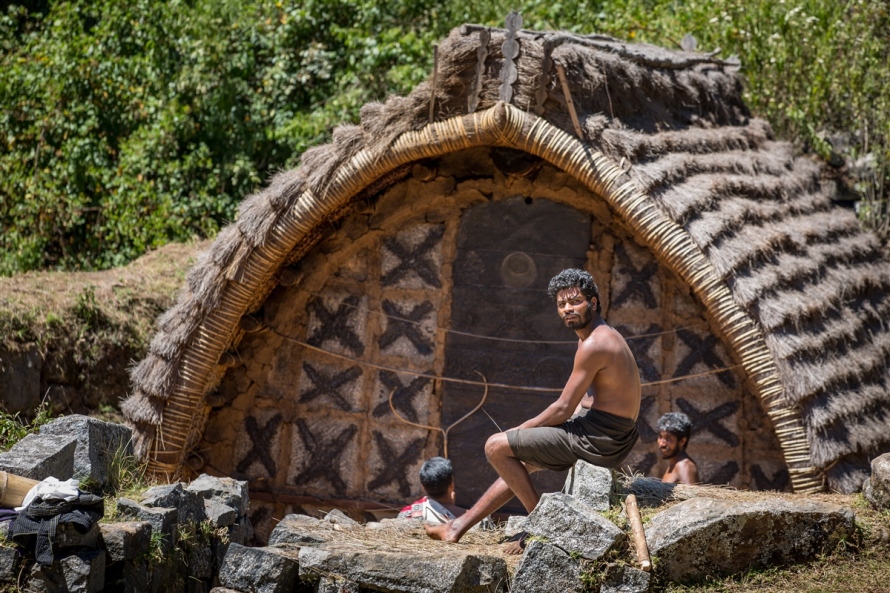
The Toda dress consists of a traditional embroidered shawl called ‘Poothukuli’ and worn from the shoulders down. This traditional costume has a special embroidery process, transmitted from generation to generation, which is now recognized and protected by the Tamil Nadu State.


Portrait of a Toda Tribe elder


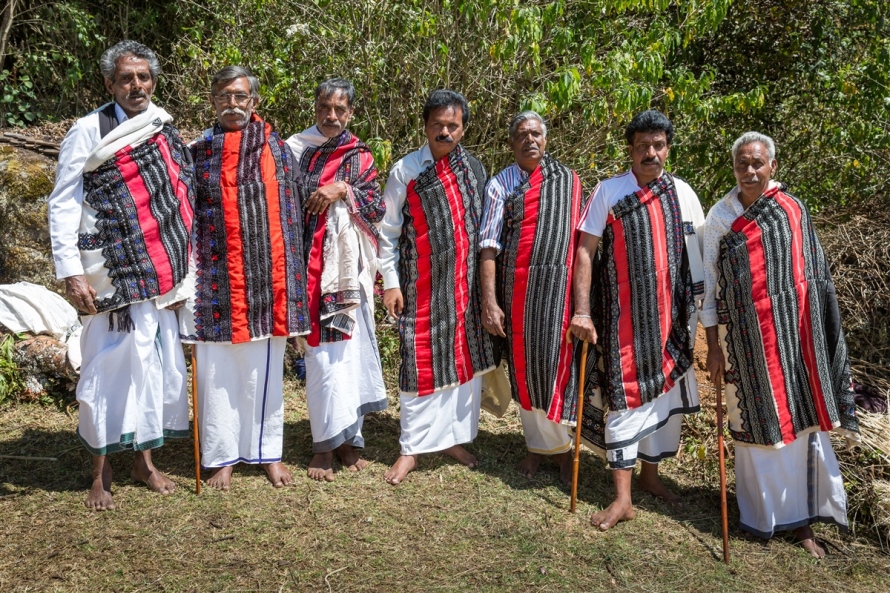

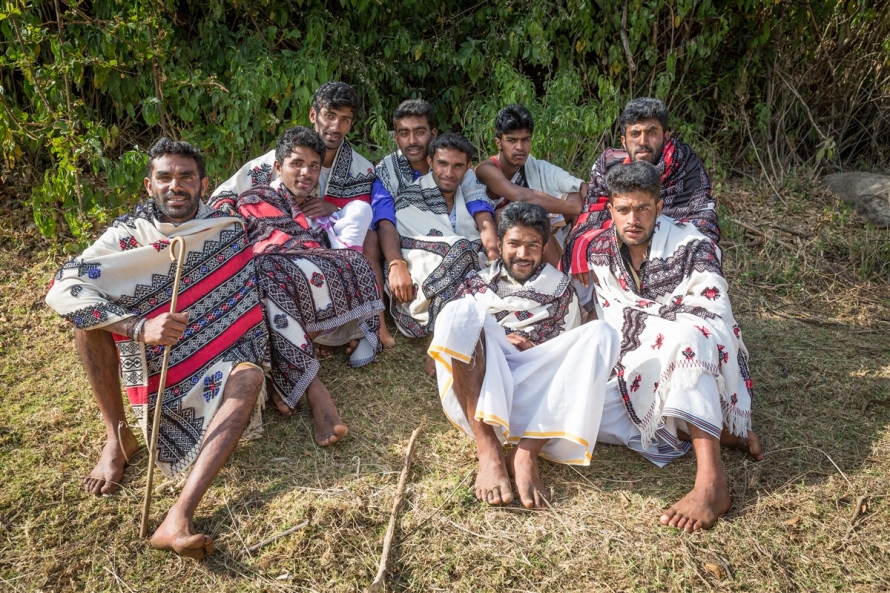
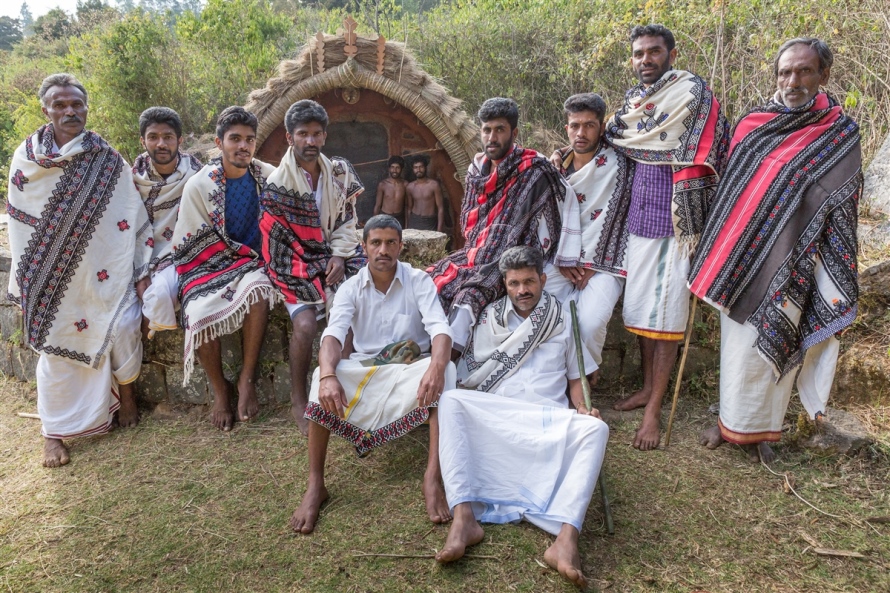

Constantly throughout the day I was made to feel welcome, I was the only non-Toda person and persistantly reminded that I was an honoured guest, offering me food and drink. I’m always a little uneasy in these situations with photography and kept asking for permission, but they were always more than happy to be photographed.
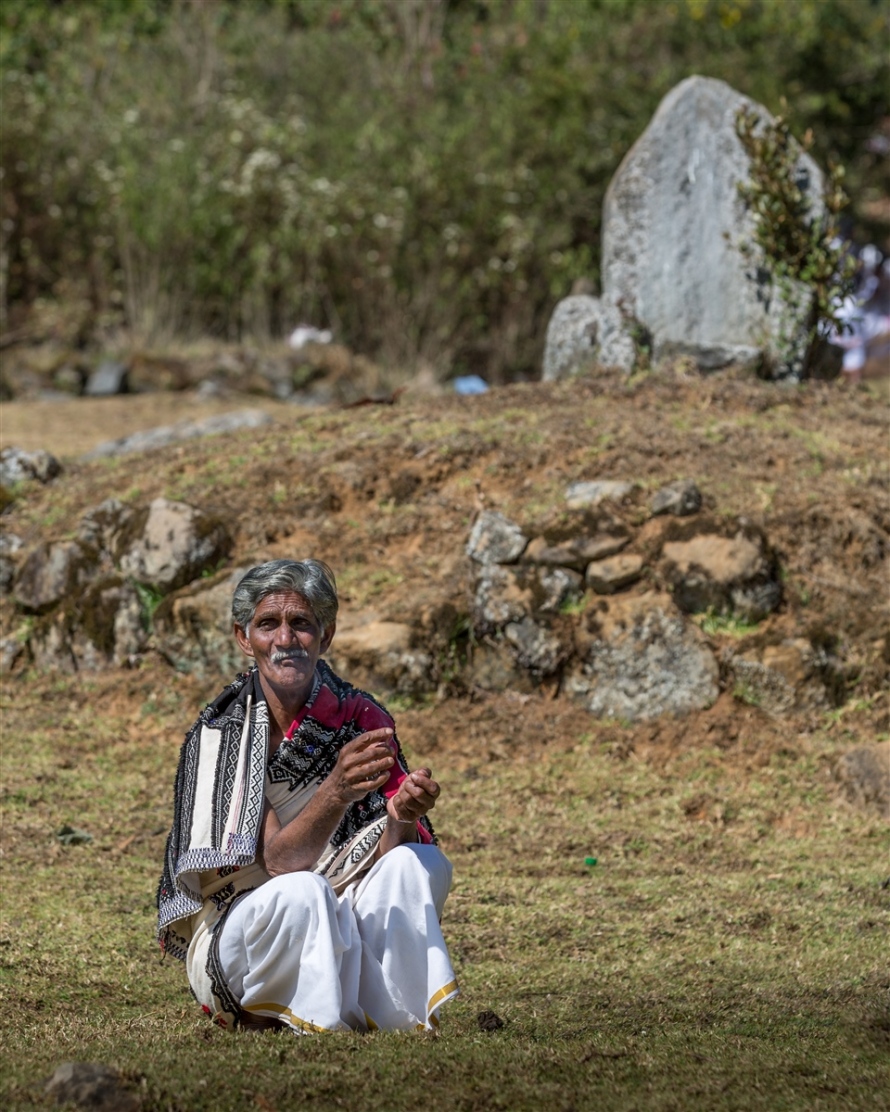


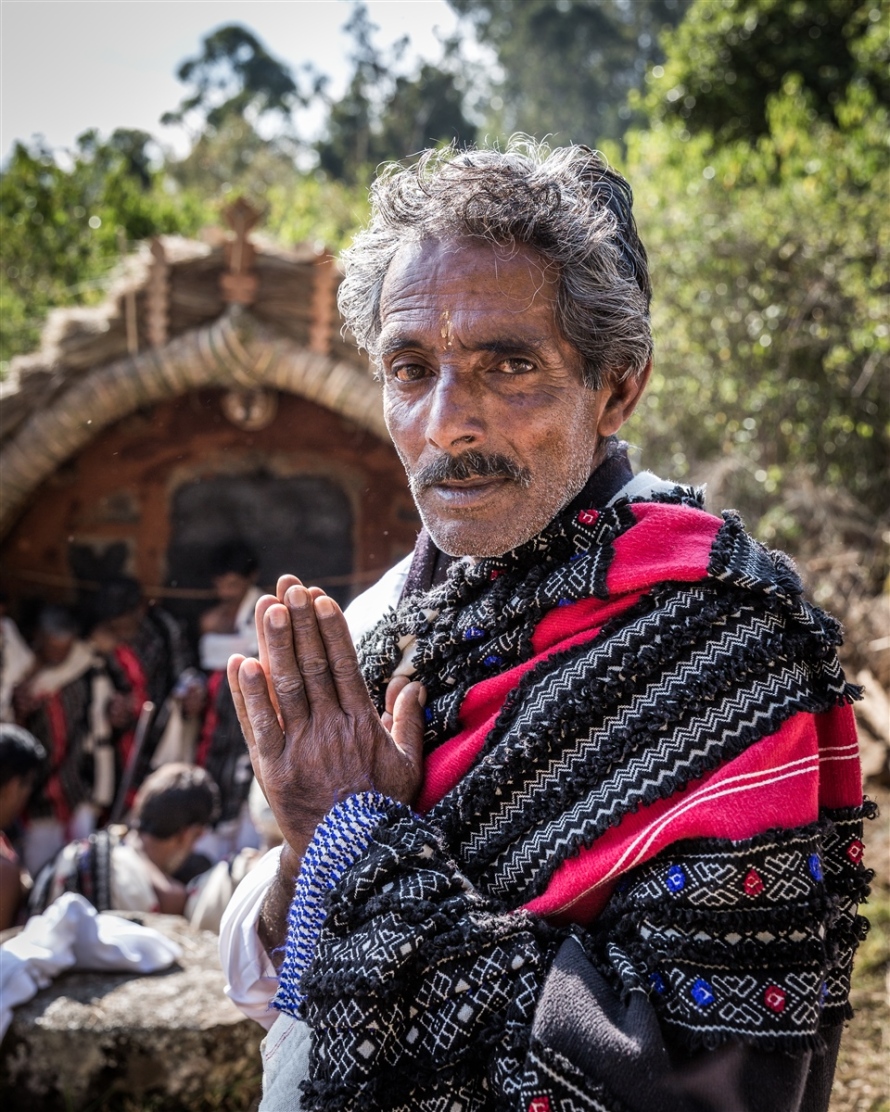

By mid afternoon the temple rethatching had concluded, and the rituals and ceremonies commenced.


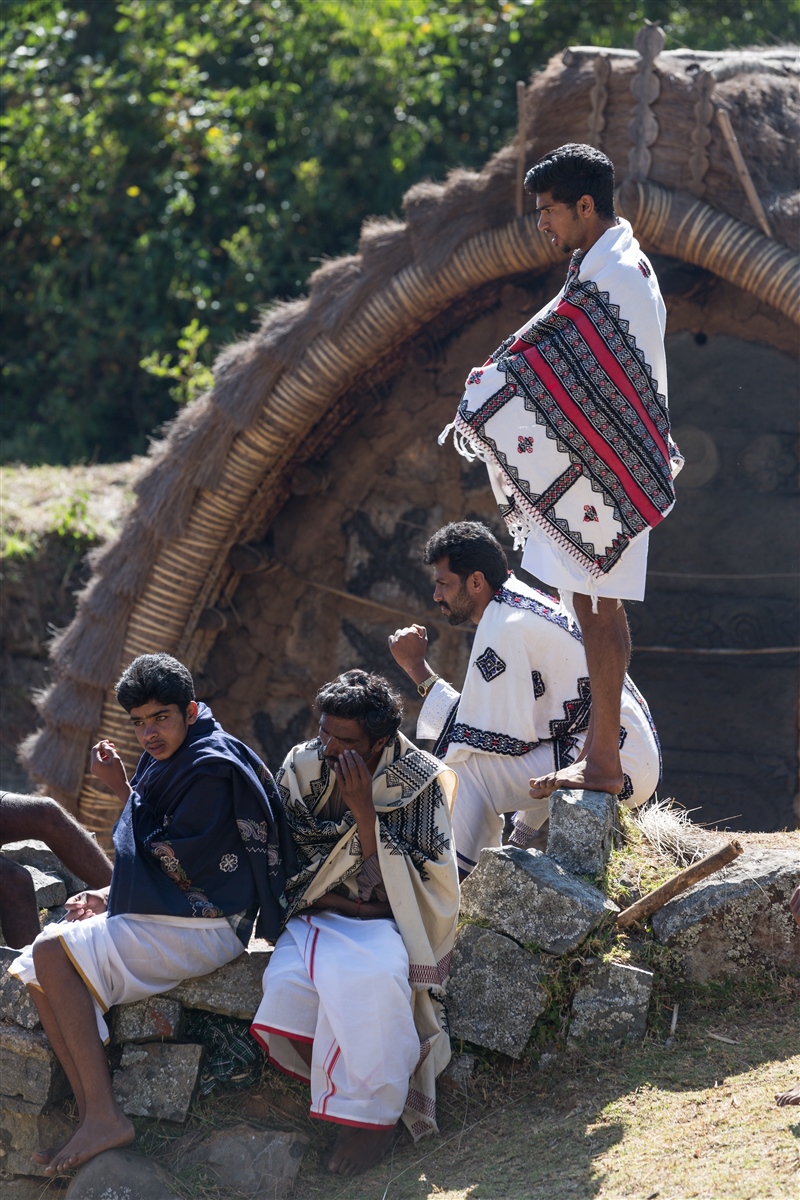







A circle was formed outside the temple entrance, and the tribe members rotated anti-clockwise chanting.

A ceremony in front of the Toda temple begins




This ceremony lasted a surprisingly short amount of time, before everyone left the temple and headed down to the foot of the field. This was where the festival and celebrations really began in earnest.


The toda tribe celebrate the completion of the temple re-thatching






Much larger circles were formed, and more chanting commenced accompanied by food and drink. This was all within the temple enclosure still, so the women remained outside the perimeter by their houses.

The toda tribe celebrate the completion of the temple re-thatching


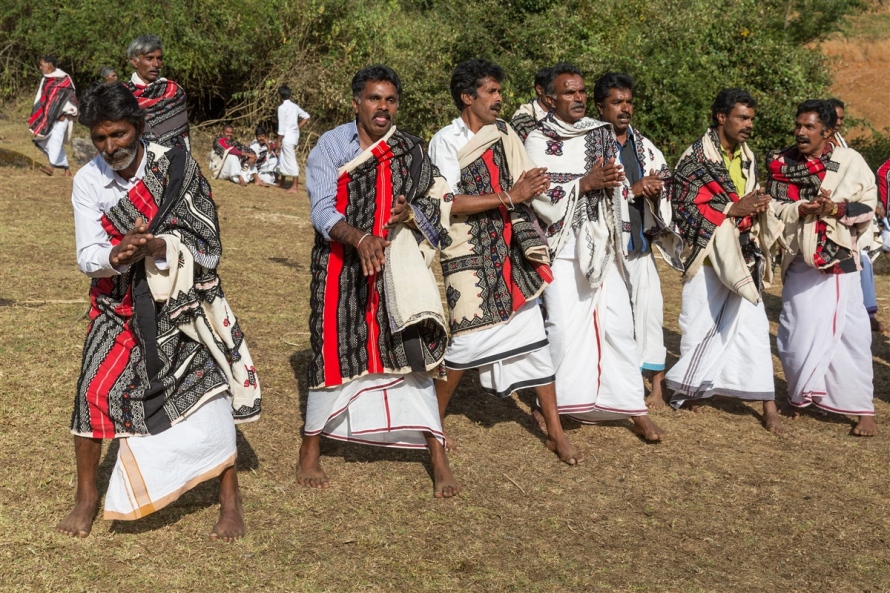




I was invited to stay as they continued their festivities, but evening was approaching and I still had no idea of where I was or how I was going to get back to Ooty. Luckily I managed to flag down a coach of architecture students from Chennai who were happy to drop me off in the center of town. Something that had been on my mind for the entire day turned out to be something of nothing, I wasn’t that far away from Ooty and getting back there was trivial as it turned out.
It’s rare for me to experience a day that I know will stay so crystal clear in my mind for the rest of my life. It was privilege to witness that day with the Toda tribe, and I am eternally grateful to them for allowing me to share the experience in such a welcoming way.
You’re welcome to ‘Like’ or add a comment if you enjoyed this blog post. If you’d like to be notified of any new content, why not sign up by clicking the ‘Follow’ button.
If you’re interested in using any of my photography or articles please get in touch. I’m also available for any freelance work worldwide, my duffel bag is always packed ready to go…
KevinStandage1@googlemail.com
Categories: India, Ooty, Tamil Nadu, The Toda Tribe





Really great post. I have heard of the Todas before but this is the most detailed post I have seen on them with great photographs too.
LikeLiked by 2 people
Thanks ! I confess that I have sat on the images for 18 months, slightly daunted by having to write so much about that day. I dare say it will get a few edits now, but just wanted to get something out there. Thanks for stopping by !
LikeLiked by 1 person
Amazing pictures and very informative commentary. I want to visit this place. Can I get details of any person who can take me there ? My email Id is bsk59purna@gmail.com
LikeLiked by 1 person
Hi Nanda, I may be able to help you with this, will be in contact shortly
LikeLike
Wow, what an experience! This was very informative and truly interesting. Your Pics were amazing an the videos worth watching. Wished you were able to capture a photo or two of their women but I understand the ceremony was performed by the men only. Thanks for such a great post.
LikeLiked by 1 person
I did meet the women of the tribe, but was sensitive towards photographing them. Thanks for your kind comments and for stopping by ! 😀
LikeLike
Thank you for following Indifferent Ignorance, I appreciate it.
Your photos are beautiful, best of luck with your travels!
Francesca
LikeLike
Love the pictures and story…had no knowledge about the tribes of India.
LikeLiked by 1 person
A case of right place at the right time, I was very very lucky 🙂
LikeLiked by 1 person
An amazing and most informative post on the Todas. I visited Ooty in August this year and climbed up the gardens to the temple but did not meet anyone from the tribal community although I would have dearly loved to do so.Thank you so much for following my blog!.
LikeLiked by 1 person
Very interesting post with lovely photos and film clips, Kevin. I knew nothing of this tribe until now. Thanks for stopping by my blog and following. 🙂 — Suzanne Joshi
LikeLiked by 1 person
What a wonderful impromptu experience for you Kevin…Am awesome post and I just love it I know very little about the different tribes of India…..A truly great read…Thank you for the follow…:)
LikeLiked by 1 person
I have been studying the Toda community since 1962 and this is the finest collection of photographic images of the people I have yet seen. Anthony R. Walker, author ‘The Toda of South India: A New Look’ New Delhi: Hindustan Publishing House.
LikeLiked by 1 person
Thankyou Anthony, I’m quite humbled to read this ! Conditions for photography were not great, and the whole day seemed to just race by. It was a privilege to spend that time with them.
LikeLike
This was brilliant! You should stay with them for some time and maybe they would discover you more secrets.
Todas are known within local tribes as divine tribe with mystical powers. Some of them can communicate with sacred buffalo in divine language they say and wodden stick they hold is not just a stick..
Many men tried to find out more about them but without sucess
LikeLiked by 1 person
It is a well detailed post!! Jealous that you witnessed their festival as well. I wanted to visit them and would like to know how to reach. My hometown is near to Ooty. Can you pls guide me and my email id is arunreal1@gmail.com
LikeLike
Namaste Arun,
I’m afraid I don’t really want to share the exact location – I was personally invited there by one of the Tribe’s elders, which is quite different to just showing up on their doorstep. As tourists we need to be sensitive to this.
If your hometown is near Ooty I suggest you retrace my steps to the temple above the botanical gardens and see if you can meet one of the Elders there – this place is a little more well known about and they are more accustomed to outsiders visiting.
LikeLike
This is such a great revelation. It’s one thing to read about it as a study or research but reading a first hand, personal experience makes it so much more realistic and admirable. I am currently doing an assignment wherein we have to study a certain culture and I happen to choose the Toda Tribe. Thank you for the insight accompanied with brilliant photography!
LikeLiked by 1 person
Thanks for visiting my blog Ankit and for your kind words. Best of luck with that assignment !
LikeLike
Awesome trip report and photos. I was in Ooty in 1990 but knew nothing of the Toda people. Learned about them later. If I go back will definitely check out their culture if I’m welcome.
LikeLiked by 1 person
Thanks Kelly, I knew nothing about them either until I decided to visit that temple. Best wishes and thanks for stopping by my blog !
LikeLike
Being in India and getting to know about India from someone who is not from India is a different feeling altogether. You are seriously very lucky to be there at the reroofing ceremony. I was going through the comment section and totally agree with the view of giving them the space and not encroaching it. Iam a student of Anthropology and had an idea about the Todas but the picture essay of yours stands out amongst whatever I have read till date.
Thank you sir for this.
LikeLiked by 1 person
Very nice article. Thank you for sharing your experience.
LikeLiked by 1 person
Thank you for visiting my blog ! 🙏
LikeLiked by 1 person
I reference my own trip to India in my featured post. It was a Buddhist pilgrimage from Varanasi to lumbini. It remains with me as a deep influence on many levels. Cheers, Kiora
LikeLiked by 1 person
thank you so much for this wonderful post with such details about the tribe and their customs. i loved the photography too ! 😛
LikeLiked by 1 person
Thank you !
LikeLike
Thank you for your wonderful pictures which captured such a unique experience. We were fortunate to meet some of the tribe members today while out walking with a local guide . Your pictures and commentary have enhanced our knowledge of this special group.
LikeLiked by 1 person
Wow – what a privilege ! I’m happy to know my blog helped you in some small way. Thank you for stopping by 🙏
LikeLike
Thank you for this wonderful post, Kevin sir.
And thanks to you I could write my substack post: https://silpasastradityam.substack.com/p/temple-architecture-styles-toda-temple
As per https://www.thevintagenews.com/2016/10/18/toda-huts-the-original-homes-of-the-toda-people-an-ancient-indian-tribe/, there is another category of Toda temples that are more sacred than the hut type. These are tall conical temples.
Not sure if you got the chance to see those temples
LikeLiked by 1 person